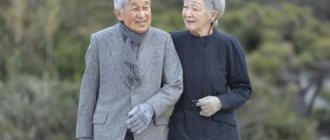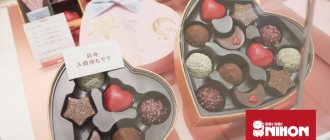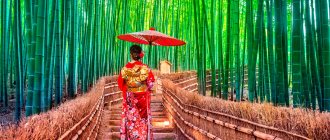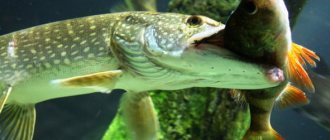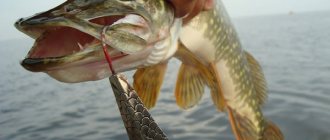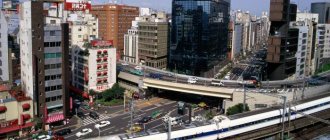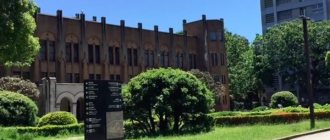Why learn characters (kanji)? Learning a writing system in which symbols represent meaning rather than sound can be fun and intellectually stimulating. For example, one horizontal line (一) is the kanji for "one", "one". Two lines are “two” (二), respectively, three lines are “three” (三). Yes, the Japanese language has a lot of characters to learn, and children memorize more than a thousand characters in six years of primary school, but the first steps along the way require little to no effort.
The hiragana and katakana syllabaries represent sounds, a familiar concept to people of different language groups. But kanji give us a new vision of the subject. Since each of them has its own meaning, they can be studied in different ways. Frequently used hieroglyphs will help you study by friendlyly pointing out the meaning of the text you are working with. Memorizing a number of these kanji will allow you to better understand the Japanese language as a whole. How many of them are worth learning and over what period is up to the student to decide.
Japanese children start by memorizing 80 kanji in first grade. Foreign students may study them in a different order; there is no standard, especially since the Japanese Language Test makers stopped publishing official lists in 2010. Some of the simplest hieroglyphs to remember are those that resemble the concepts they represent. These range from very simple characters from a few strokes such as 木 (tree) and 山 (mountain) to more complex ones like 鳥 (bird).
Learn 100 kanji in an hour
Greetings, Friends! Igor Korotkov is with you. You are on the website Venasera.ru. Today we will talk about how you can memorize more than 70-100 of your first hieroglyphs in an hour and even make words from some of them!
Part 1
Part 2: 78 hieroglyphs
Part 3: 100 hieroglyphs
If you are familiar with our channel, then you know what equipment we will use today! Of course, this is our favorite mnemonic. But under no circumstances should you perceive mnemonics as a panacea technique that will magically solve everything for you. If everything is done correctly , then mnemonics will solve most of the memorization problems .
However , you definitely need to combine several options for learning a language at the same time, i.e., for example, both mnemonics and the method of spaced repetition with memory cards are applicable to hieroglyphs . For example, you can use this combination, it usually works well. Never try to simply memorize information , especially hieroglyphs. You will spend much more effort and time on simple cramming .
Again, I want to remind you, in order to better remember this or that hieroglyph, you need to come up with your own mnemonic images , but for an example (or if you can’t come up with anything), at first you can use these images, which will be given in this lesson.
Today we will analyze only hieroglyphs and their meanings, without readings.
We will practice hieroglyphs block by block ! After each completed block, I recommend once again remembering your image and checking whether you remembered correctly? And then combine all the blocks . You can print out blocks with hieroglyphs and make cards from them, practicing each block separately, and then secure them by connecting everything together.
Kanji blocks (part 1): https://bit.ly/1X9D5No
Kanji blocks (part 2): https://bit.ly/1lNIeiF
It is important to understand that the better you imagine a phrase with an image, the better you will be able to remember this hieroglyph . I will say that this works well for everyone , the question is how correctly you apply it. The image should be original, not standard! The weirder, more perverted or funnier the image, the better it will settle in your head . Over time, the images will disappear and only the kanji will remain. Just as in the video with Japanese alphabets (Hiragana and Katakana), I repeat that mnemonics are needed for a while so that the hieroglyph is stored in memory. After a few days of spaced repetition, the kanji should be remembered much faster than the image and soon the image itself will be forgotten.
Repeat cards with kanji for at least 5-6 days and then you will remember everything.
Let's start the mnemonic chain with the simplest hieroglyphs.
Block 1
人 – Looks like a person with legs.
大 – Big (let’s mentally imagine a “giant man” who waved his arms) or a giant who caught a big fish and brags about it.
大人 – If you put 2 hieroglyphs next to “Big” and “man”, then it will be “Adult”. Those. a big person is an “adult”.
太 – If the “Giant” has a dangling belly, he is “fat”.
犬 – If the Giant has something on his shoulder, then this “dog” is sitting on the giant’s shoulder.
天 – Let’s imagine a giant whose head reaches to the “sky.” This is the hieroglyph for "sky".
夫 – And if the giant’s head is above the heavens, then it means he is a “husband”, his head soars above the clouds with happiness.
入 – Imagine a 2.5 meter tall man who came to Japan. In order for a person to “enter” any door, he needs to bend down! Hieroglyph "to enter".
Block 2
口 – Mouth (similar to a mouth) or the syllable “RO” from katakana.
品 – 3 mouths are a “product”, you can remember as “3 mouths talk about a product” or just imagine that this is what boxes with goods that are loaded for shipment look like.
兄 – “Mouth on legs” – this is the older brother. Imagine how your older brother constantly runs after you and yells with his huge mouth. The big brother's mouth is as big as his head!
Along the way, as a bonus, we will remember several words made up of previously learned kanji.
人口 - If we put 2 characters “man” and “mouth” next to each other, then we can remember the word “population” by the phrase “how many human mouths live in Tokyo?”
入口 - If you put 2 hieroglyphs “enter” and “mouth” next to each other, it will be “entrance”. This is how signs with the word “entrance” are written.
日 – The kanji for “day” or “sun” is very similar to the sun.
白 – white (“white” ray of the sun) or can be remembered as “the white sun emits 1 white ray”
百 – Substitute one for “white” and you get “one hundred.” One white sun is equal to 100 primes. Or, if you turn the kanji horizontally, you can see the outline of the number 100, but it’s better to stick with the first option.
目 – Eye (looks like an eye).
自 – Yourself, your own. Imagine, you have only 1 eyelash near your eye , you are walking with a friend and he says to you: “Let me pull it out, you only have one anyway,” and you answer “No! I’ll pull it out myself !”
見 – If you add “legs” to the element “eye”, then the hieroglyph “look” will appear. Let’s imagine how a huge eye on legs runs around the apartment and “looks” intently at you!
Block 3
木 – The character looks like a tree. The trunk and branches are visible here.
林 – Two trees are a “grove”
森 – Three trees are a “forest”
Let's try to remember the hieroglyph “man”, do you remember what it looks like? 人
If a person is part of another character as a constituent element, then he will look like this if he stands on the left in the character イ and like this if he stands at the top “今”.
So, the next hieroglyph will consist of two elements that we went through earlier.
休 – A man “rests” under a tree, the hieroglyph for “rest.”
東 – If the sun peeks out from behind a tree, then it is “east”, because the sun rises earlier where? That's right, in the east! “The sun comes out of the east from behind a tree.”
本 – Tree with a serif at the bottom – “Book”. Let's imagine that a robot chainsaw cuts down a tree, and then takes the cut down tree to the production of “books”! The tree is the “source of books”!
I strongly advise against memorizing 2 different meanings of a word, but here we will deviate from the rule and remember 2 meanings at once by memorizing two sentences. You can also imagine that the root is the “source” of the tree.
体 – And if a person stands and uses sandpaper to saw a tree into books, then he will pump up his “body” faster than cutting it down. Imagine a groaning person whose whole body already hurts.
So, the land of the rising sun will be Nihon: “Sun” + “source” 日本 Japan
Block 4
田 – field, similar to a field.
川 – river (there are banks along the edges, and here the “river” flows), or can be remembered as “3 rivers”
州 – state, province: 3 states are separated by 3 rivers!
土 – earth: the character looks like a sprout that grows from the ground.
士 – if the upper horizontal line of the “earth” is longer than the lower one , then this is the hieroglyph “warrior”. We will remember this as “relative to the earth, the warrior is greater.” Imagine a warrior becoming larger than the globe.
火 – Hieroglyph “Fire”. Looks like a fire.
山 – Hieroglyph “Mountain” (looks like a mountain)
火山 – what do you think will happen if you put 2 hieroglyphs next to each other: “fire” and “mountain”? What is fire mountain? Right! This is a "volcano"!
出 – if it turns out that two mountains are on top of each other, then you can remember this as “another mountain comes out one mountain” (imagine how one mountain gives birth to another mountain and another mountain comes out of one mountain!) kanji “to come out”.
出口 – by analogy with the word “entrance”, we will remember “exit” by placing 2 hieroglyphs “exit” and “mouth” next to each other
The hieroglyphs up and down are very easy to recognize; they look like arrows 上 “up” and 下 “down” relative to the ground.
The hieroglyph 右 “right” and 左 “left” look like a swimmer who is faced with a difficult choice: if I swim to the right, he thinks, I’ll eat a big mouth, if I swim to the left, I’ll eat an elevator (it’s an elevator, because as you remember the katakana syllable E, we remembered how "elevator")!
手 – Kanji for hand, looks like a hand.
上手 – If you have done something “skillfully”, then you will always be shown a “thumbs up”, 2 hieroglyphs “up” and “hand” (i.e. finger up) - “skillful”
下手 – If you did something “ineptly”, then you will always be shown “thumbs down”, 2 hieroglyphs “down” and “hand” (i.e. finger down) - “inept”
右手 – Right hand.
左手 – Left hand.
Block 5
Now, let's run through the numbers:
1, 2, 3 - everything is clear with them - yes.
四 – you’ve probably all heard that the number 4 in eastern countries is associated with death, because there is a similarity in pronunciation. So this is a coffin and the legs of the dead man are sticking out of the coffin.
五 – try to draw the number 5 on the hieroglyph itself, it’s very similar, isn’t it? Especially if you round off the sharp ends.
六 – Six is like a 6 watt lamp.
七 – 7 is an inverted seven.
八 – similar to the katakana syllable HA and it is read as “Hachi” eight, easy to remember if you watched the previous video “how to remember katakana” and the video with counting.
九 – nine is somewhat similar to the English letter N, can be remembered as Nine – “nine”. Or it looks like the number 9.
十 – ten is very easy to remember – just a cross. If you need to come up with an image for it, then simply turn over the Roman ten. This is the most hackneyed example.
From the previous video we learned how to count to 99 in Japanese, and now we learned how to write to 100. Do you remember how we write 12, 34, 99? Great! Let's move on.
古 – if you see a tombstone made of the elements “10” and “mouth”, know that “10 “old” mouths are buried here”! Nobody knows where the bodies are.
早 – if you attach ten down to the “day” element, it will be “early, quickly”, remember that “the sun rises at 10 am, and this is “early”!
草 – we substitute the element grass to the hieroglyph “early” and we get the hieroglyph “grass”. The grass rises before everyone else!
西 – if a dead man’s legs come out of the coffin, it means the dead have risen and are going to Hollywood, i.e. to the west".
千 – thousand. Stick a line to the top of ten - it will be “thousand”
Block 6
力 – remember KA from katakana? The hieroglyph “strength” is very similar to it.
男 – If you put force into the field, it means “men” are working there. There will be a man!
女 – The character looks like a woman. Legs, apron, body.
安 – If you put a woman under a roof, the hieroglyph will be “Cheap, calm,” let’s remember this as “A woman under a roof is always calm.” First, remember one thing, you don’t need to try all the meanings at once, but if you are sure that you can remember both meanings, then you can try.
Block 7
子 – the child is easy to remember and so, the outlines of a child with a big head can be traced in it.
好 – a woman “loves” her child, the hieroglyph for “love, like”
学 – if the “child” has a “halo of knowledge” over his head (we will use this word for this element), then the child is “learning”.
字 – if instead of a halo the child has a “roof” over his head, then this is a “sign, symbol, hieroglyph.” A child under the roof writes down “hieroglyphs.”
By the way, the kanji word is written with exactly this hieroglyph かん字. We don’t know the hieroglyph Kan, but we just passed “Dzi”.
大学 – what do you think these 2 hieroglyphs mean when placed side by side? “Big Study” - This is a “university”!
If the lid has one line, then I imagine a house with a chimney, and if the lid has 3 lines, then this is an educational institution, because there are many pipes to heat a large room. Or you can remember that this is a halo of knowledge.
Block 8
門 is the hieroglyph for “gate”, here we see the same gate.
問 – if there is a “mouth” at the “gate”, then this is the hieroglyph for “ask”.
聞 – if there is an “ear” at the “gate”, then this is the hieroglyph for “listen”.
耳 – by the way, the hieroglyph ear looks like a real ear, if you look closely.
間 – if there is a “sun” at the “gate”, then there will be “gap, interval”. After all, “between” the gate and the sun there is a huge “interval/gap”!
Block 9
言 – imagine how your mouth makes different sounds! You can find similarities with the sound waves icon. If the mouth produces sound waves, it means it is “talking”! Kanji for "speak".
語 – language. “Five mouths speak different languages and not one language is understood”! Kanji for "language"! Imagine how everyone speaks some languages, and you are not the only one who does not understand, because you only know Rosia-go (Russian language), substituting the country for the hieroglyph “go” will be “such and such a language”. ロシア語 – Russian language, 日本語 – Japanese language, ドイツ語 – German language, etc.
中 – the middle is easy to remember without mnemonics.
虫 – if you draw a tail in the “middle”, then it will be an “insect”. It looks like a snake, or more precisely a cobra. You can remember how “a cobra fights a giant insect.”
仲 – If the element “person” is to the left of the middle, then it will be the kanji for “relationship with someone.” You can remember it as “the person is the middle of the relationship.”
Block 10
立 – Remember character 6? Now let’s look at a similar hieroglyph – “stand”, as you can see the kanji looks like a person standing on the ground. Not to be confused with 6, in 6k there is no earth, there is a lamp that shines, and here is “a man who stands on the ground.”
音 – If you put the “sun” element at the bottom, there will be “sound”! You can remember how “the loud sound is only during the day!”
暗 – And if you substitute another “sun” on the left to the “sound” on the left, then it will be “dark”, let’s remember this as “if the person standing is surrounded by 2 suns, then this is some kind of dark magic”
米 – Remember the kanji for tree? If you add 2 grains of rice to a tree, you get “rice”! After all, if you didn’t know “in Japan, trees produce rice”!
迷 – If rice goes along the road, it means it is “lost”! And this is the “road” element. Let's imagine rice walking along the road and crying, it got lost and is looking for its owner!
Block 11
車 – the kanji for “cart” is “car”. Look carefully, you can see that this is a car, there are 4 wheels and one seat in the middle. If you remember the Tetris car game that we all played as children? This is it.
重 – if you book the car and put a couple more wheels on it, then it will already be a “heavy” armored car!
動 – Here we see that the “strength” element has been added to the armored car on the right. To “move” the “armored car” you need to add “force”! Hieroglyph "to move, to move."
働 – if “an armored car is moved by force by a person, then this means that it is not the armored car that is “working”, but the person”!
To conclude the block, let's look at another word car, which consists of as many as 3 kanji that we went over earlier. 自動車 – pause and remember all 3 kanji. Yes, this is “self” “move” “machine” the word “car”.
This is a shortened version of how you can collect many hieroglyphs in a chain. Essentially, it’s like a construction set, you need to remember this or that element for yourself and simply assemble the construction set from parts, of which there are not so many, only 214 pieces.
That's all for today. If you have more colorful images and associations, please write them in the comments, because... it would help our community move forward.
If you liked the video, like it, tell your friends, subscribe to our channel and public in contact, Igor Korotkov was with you. See you!
Repetitions
At school we are told to learn words this way: read the word 10 times and “just remember it.” Nobody explains exactly how to remember a word, so most often we blame ourselves for not being able to remember new vocabulary as quickly as we would like. This cramming method may work, but it is one of the most ineffective ways to learn a language. By repeating a word N times and simply relying on our memory, we do not take into account the fact that the first two hours after reading we remember this word well, but we will not remember it the next day, much less in a week or a month. Kanjiway solves this problem with its spaced repetition system. This is a very simple but powerful concept that allows us to learn not only foreign languages, but also any information that we would like to remember. Instead of trying to repeat words ourselves when it seems necessary to us, an algorithm works for you that distributes repetition dates many days in advance. Let's say today you learned a new kanji and would like to remember it. Kanjiway automatically chooses a time when it's useful for you to repeat it next time, based on data such as the difficulty of that kanji, the number of repetitions completed, the time it takes to recall the kanji, your learning progress, and so on. This way, you don't have to keep in mind which of the 2136 kanji you need to repeat at what point. Kanjiway every day and you will always have that list of kanji that you need to repeat today, specially optimized for your path of learning kanji.
Order
In addition to all of the above, we can say that it would be a good idea to not just learn kanji in random order, but to arrange them in the order that will be most effective for you. Kanjiway uses the following principles when choosing which kanji you need to learn next:
- We're basing this on how popular the kanji itself is in the Japanese language. You will be much better off learning the most common kanji first, such as "money", "today", "food", rather than the rarer ones, such as "power plant", "princess", "bamboo tree".
- We look at the kanji you have already learned and your progress in memorizing and repeating them, the following kanji will be selected specifically to make it easier for you to learn them.
- We look at what kanji are taught in Japanese schools and in what grades. We will try to make your learning path similar to what the Japanese themselves go through when learning kanji.
